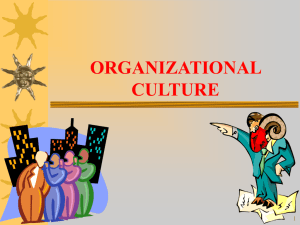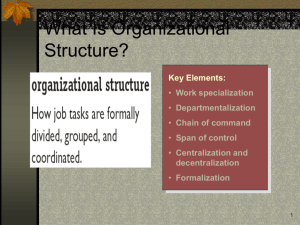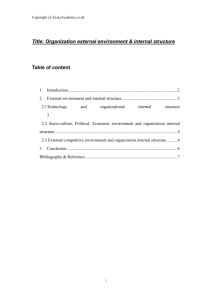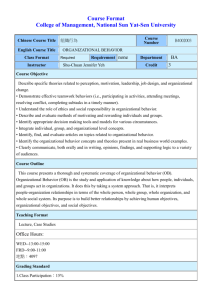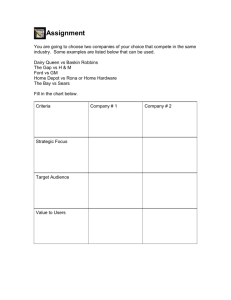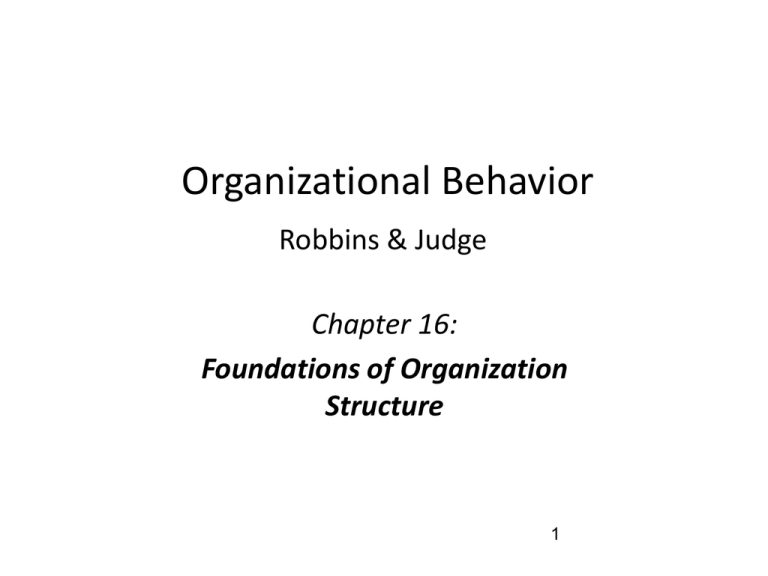
Organizational Behavior
Robbins & Judge
Chapter 16:
Foundations of Organization
Structure
1
Summary of Lecture 29
-
Emotions and Moods
-
Sources of Emotions and Moods
-
External constraints on Emotions
-
Impact of emotional labor on employees
-
Affective Events Theory
-
Emotional Intelligence
-
OB Issues and Emotions
-
OB Issues and Moods
2
Robbins
Robbins and
and Judge
Judge (2008):
(2008): Organizational
Organizational Behavior,
Behavior, Pearson,
Pearson, Prentice
Prentice Hall
Hall
Learning Objectives
-
Organizational Structure
-
Characteristics of Bureaucracy
-
Describe Matrix Organization
-
Why managers want to create boundary-less organizations
-
List the factors that favor different organizational structure
- Explain behavioral implications of different organizational
structures
3
Robbins and Judge (2008): Organizational Behavior, Pearson, Prentice Hall
What Is Organizational Structure?
- How job tasks are formally divided, grouped, and
coordinated
Work specialization
Departmentalization
Chain of command
Span of control
Centralization and
decentralization
Formalization
To what degree are activities subdivided into
separate jobs?
On what basis will jobs be grouped together?
To whom do individuals and groups report?
How many individuals can a manager efficiently
and effectively direct?
Where does decision making authority lie?
To what degree will there be rules and
regulations to direct employees and managers?
4
Robbins and Judge (2008): Organizational Behavior, Pearson, Prentice Hall
Work Specialization
Henry Ford earned fortune by building automobile on
assembly lines
Every workers was assigned a specific and repetitive task
Breaking jobs into small and standardized tasks he was able to
produce a car in 10 seconds
Employees having limited skills
Productivity increases in short run if employees perform
repetitive tasks
Employee attain highest level of expertise
The concept gained popularity as division of labor and work
specialization
5
Robbins and Judge (2008): Organizational Behavior, Pearson, Prentice Hall
Work Specialization
Each individual perform specific activity of job in which he
specializes
Less time require for changing tasks
It is easier for organization to train and attract worker to do
specific and repetitive tasks
Work specialization increases efficiency by introduction of
innovative machinery
Later on it was found that repetitive tasks result into boredom,
fatigue, stress, low level of productivity and increased
absenteeism
Still this approach is in practice and offer economies in several
6
jobs. For example McDonald, Car Manufacturer
Robbins and Judge (2008): Organizational Behavior, Pearson, Prentice Hall
Work Specialization
Work specialization offer benefits but later on it reaches to
point of diminishing
It is believed that job enlargement offer greater efficiencies
7
Robbins and Judge (2008): Organizational Behavior, Pearson, Prentice Hall
Departmentalization
After division of jobs through work specialization it is needed to
group these jobs together so common and dependent tasks
can be coordinated
Departmentalization is used to group jobs
Group activities is often based on functions performed
Manufacturing Organization might group jobs in departments
like engineering, finance, production, purchase, and HR
(personnel administration)
Departmentalization by functions is every where and in every
organization
Jobs can also be departmentalized by the type of product the
organization produces (FMCG often use this) 8
Robbins and Judge (2008): Organizational Behavior, Pearson, Prentice Hall
Departmentalization
Departmentalization by geography or territory (region)
In Process departmentalization jobs are grouped into
departments specializes in specific phase in the production
For example: Aluminum tubing plant can be departmentalized
in casting, press, tubing finishing and inspecting.
Process formula is also applicable in service sector. NADRA,
LICENCE Office
Customer based departmentalization
Microsoft uses this type of grouping to reach to particular
customers having distinct set of needs. Large corporations,
small business, home users
9
Large corporations may use all type of departmentalization
Robbins and Judge (2008): Organizational Behavior, Pearson, Prentice Hall
Chain
of
Command
The chain of command can be describes as unbroken line of
authority from top management to lower staff in which every
body is clear to whom report and seek directions
Authority: Refers to the right inherit in management position
to give orders and expect orders to be obeyed
Each manager in organization is given authority to perform his
job responsibility
Unity of Command: It means individual should have only one
superior to whom that person report and responsible
The concept of chain of command is diminishing in
organizational design with the development in technology and
information tools
The concept of empowering employees also contradict chain
of command design. Team work and Self management team
and concept of multiple bosses eliminating this10concept
Robbins and Judge (2008): Organizational Behavior, Pearson, Prentice Hall
Span of Control
How many employees can each manager efficiently and
effectively direct?
Span of control determines number of managers and level of
management in the organization
Wider span means more employees under control/supervision.
In other fewer managers are needed to run the organization
At the same time wider span means ineffective or less
supervision and control
Narrow span result into more close supervision
At the same time disadvantage with narrow span of control is
i) Salary budget increases ii) Vertical communication becomes
more complex and iii) discourage employee autonomy
11
Robbins and Judge (2008): Organizational Behavior, Pearson, Prentice Hall
Span of Control
In recent years, wider span of control is gaining acceptance
because of certain reasons given as follows
Reduce cost, increase flexibility, speed up decision making,
and empower employees
Organizations are investing on training of employees to
decrease likelihood of ineffectiveness inherit in wider span of
control design
Because trained employees can perform their work with
efficiency and can handle problems at their own or can consult
colleagues
12
Robbins and Judge (2008): Organizational Behavior, Pearson, Prentice Hall
Centralization and
Decentralization
In past organizations were more centralized, however in recent
years decentralization is more common
Centralization means degree to which decision making power
is concentrated at single point
It includes concept of formal authority
If employees is consulted or given authority to make decision,
the organization is more decentralized
Decentralization offer certain benefits
13
Robbins and Judge (2008): Organizational Behavior, Pearson, Prentice Hall
Formalization
Formalization means degree to which jobs in the organization
are standardized
In case of formalization, job incumbent has very little discretion
on his work. What, when and how it is to be done
In formalized job clear cut organizational rules and policies that
determine job behavior and tasks. Standard operating
procedures means clear guidelines what and how to perform
job tasks means little deviation from standardized work
behavior
Degree of formalization varies from job to job and form
organization to organization. In some professions and jobs
formalization works whereas in some professions less
formalization is more effective way
14
Robbins and Judge (2008): Organizational Behavior, Pearson, Prentice Hall
Organizational Design
The Bureaucracy
Disadvantages:
Interdepartmental conflicts
Strict rules and regulation at time does not answer the situation
Innovative and flexibility benefits are not there
15
Robbins and Judge (2008): Organizational Behavior, Pearson, Prentice Hall
Organizational Design
The Matrix Organization
Combine two forms of departmentalization: functional and
product
Employees in the matrix have two bosses their functional
department manager and product manager
Example: University: Academic departments like
Marketing, Finance, Economics are functional
departmentalization and over which specific programs
(product that is BS, MS, PhD) is overlaid on the function
Teacher of Marketing department teaching course at
undergraduate level. He may report to Head of Marketing
department and In-charge undergraduate program
16
Robbins and Judge (2008): Organizational Behavior, Pearson, Prentice Hall
Organizational Design
The Matrix Organization
Advantages:
Organizational goals gain value and priority
Better communication and more flexibility as organization grow and things
get complex
Efficient allocation of specialist
Disadvantages
Power struggle
Conflict when it is not clear to whom what to report
Reporting to more than one boss creates role ambiguity and role conflict
17
Robbins and Judge (2008): Organizational Behavior, Pearson, Prentice Hall
Organizational Design
The Simple Structure
In simple structure low degree of formalization and
departmentalization, wide span of control, centralized authority,
one man decides things and two or three vertical levels
Also called simple structure
Example: Retail Store, Small private firms. Owner also
Manager
Suitable for small business but when business grow it can be
ineffective because it is near to impossible to make all
decisions in the organization by one man. Assimilate and
interpret all information. Control all employees
18
Robbins and Judge (2008): Organizational Behavior, Pearson, Prentice Hall
New Organizational Designs
Team Structure
When organizations use teams to organization work activities it
is said to be horizontal organization or team structure
Organizations use cross functional and self managed teams
Advantages
Decentralization
Break departmental barriers
Employees are generalist and specialist as well
Better decision making and problem solution
19
Robbins and Judge (2008): Organizational Behavior, Pearson, Prentice Hall
New Organizational Designs
The Virtual Organization
Why to own when you can rent?
Also called network or modular organization
Different companies having specialties in specific area come
together to accomplish project
When large organization use the virtual structure they
frequently outsource manufacturing
Advantages
Not lasting organization to maintain, project completed team dismantle
Wide variety of skills and expertise are used at work.
Example: Mega construction, P&G outsource its IT operations
Disadvantage: Issue of management control on business activities
20
Robbins and Judge (2008): Organizational Behavior, Pearson, Prentice Hall
The Virtual Organization
Independent research
and
development firm
Advertising agency
Executive
group
Factories in South Korea
Commissioned sales
representative
21
Robbins and Judge (2008): Organizational Behavior, Pearson, Prentice Hall
New Organizational Designs
The Boundaryless Organization
The boundaryless organization seek to eliminate chain of
command, little span of control, and empowered teams instead
of departments, removing vertical hierarchies
Internal barriers across department can be reduced by transfer
posting of employees in different department and using cross
functional teams
External boundaries are eliminated by forming joint venture
and strategic alliances
Information technology is encouraging and facilitating to
realize the concept of boundary less organization
22
Robbins and Judge (2008): Organizational Behavior, Pearson, Prentice Hall
New Organizational Designs
We can categorized discussed designs into two extremes
1 Mechanistic Model
-
High specialization
Rigid departmentalization
Clear chain of command
Narrow span of control
Centralization
High formalization
2 Organic Model
- Cross functional teams
- Cross hierarchical teams
- Free flow of information
- Wide span of control
- Decentralization
- Low formalization
Robbins and Judge (2008): Organizational Behavior, Pearson, Prentice Hall
23
Organizational Designs
The question arises why different organizations follow different
structures?
What are the forces that influence organizational design?
Strategy
Strategy
Structural Options
Innovation
Organic: Loose structure, low
specialization, low formalization,
decentralized
Cost minimization
Mechanistic: tight control,,
extensive, work specialization,
high formalization, high
centralization
Imitation
Mechanistic and Organic: Mix of
loose with tight properties, tight
controls over current activities,
and looser controls for new
undertaking
24
Robbins and Judge (2008): Organizational Behavior, Pearson, Prentice Hall
Organizational Designs
Organization Size
Technology
means how input s are transferred into out (Process:
routine activities non routing activities)
Environment
Stable and Dynamic environment
Simple and Complex
25
Robbins and Judge (2008): Organizational Behavior, Pearson, Prentice Hall
OB and Organizational Designs
Work specialization
-
Higher employee productivity at the cost reduced job satisfaction
Consider Individual differences
Span of Control
- Wider span of control may result into employee satisfaction and higher
performance
- Consider Individual differences
- How employees and managers feel
Centralization and Decentralization
To maximize employees satisfaction and productivity consider
- Individual differences
- Work task
- National Culture
- Individuals work for organization where they find themselves fit
26
Robbins and Judge (2008): Organizational Behavior, Pearson, Prentice Hall
Managerial Implications
Internal structure contribute in explaining and predicting individual
behavior
Structure limits and control what employee do?
How employee perceive organizational structure it is more predictive
of their behavior
Structure should be matched with strategy
Also consider other factors such as size, technology and environment
before deciding structure
Whatever structure you choose employee and management should
know what is objective and make it more clear that every body
understand prevalent structure in the organization
Make easier to change the structure according to needs and situation
27
Robbins and Judge (2008): Organizational Behavior, Pearson, Prentice Hall
Discussion Questions
Discussion Question 1: What is purpose of organization
design?
Discussion Question 2: In your opinion which organizational
structure is best?
Discussion Question 3: If organization is pursuing
innovative strategy which structure best fits?
Discussion Question 4: What is influence of organizational
structure on work performance?
28
Summary
-
Organizational Structure
-
Characteristics of Bureaucracy
-
Describe Matrix Organization
-
Why managers want to create boundary-less organizations
-
List the factors that favor different organizational structure
- Explain behavioral implications of different organizational
structures
29
Robbins and Judge (2008): Organizational Behavior, Pearson, Prentice Hall

